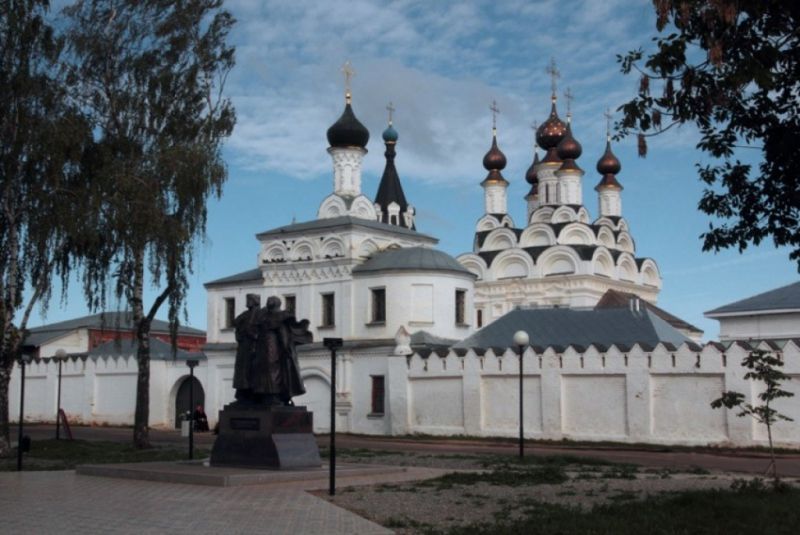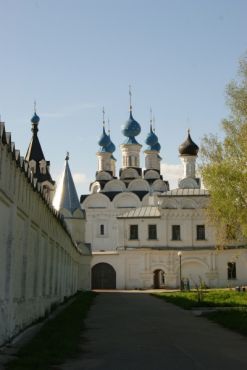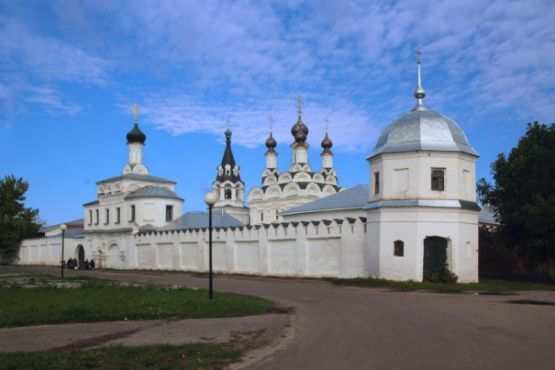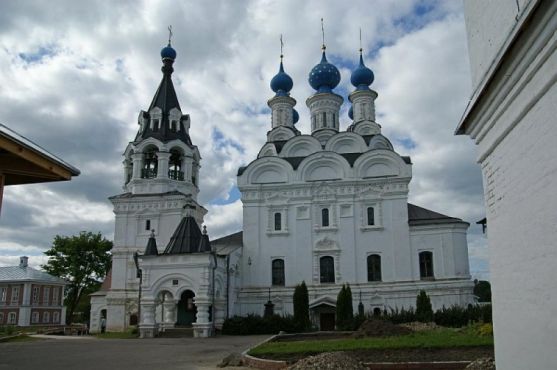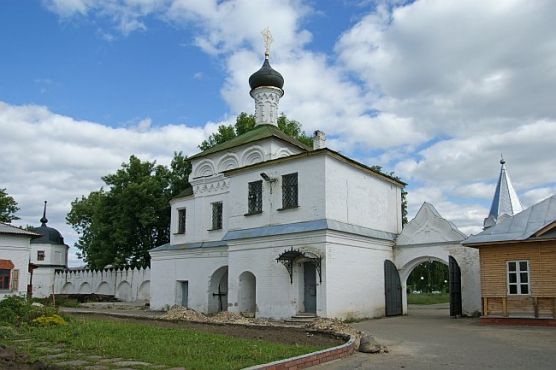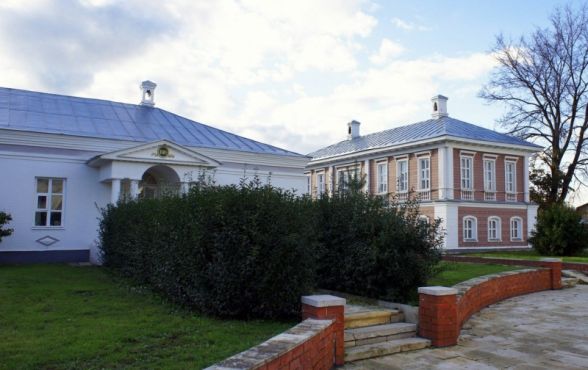Holy Annunciation Monastery
- Address:
- Murom, Krasnoarmeyskaya street, 17
- GPS:
- 55.58244533, 42.05366746
- Phones:
- +7 (49234) 2-05-02, +7 (49234) 2-09-78
In the center of Murom, literally "shoulder to shoulder" with the Trinity Monastery, there is a magnificent Annunciation Monastery. The history of the Holy Annunciation Monastery is rooted in the period of the baptism of the Murom land at the turn of the 11th-12th centuries, which is connected with the name of Prince Constantine (Yaroslav) Svyatoslavich. His sons Mikhail and Theodore helped him in this mission. In "The Tale of the Establishment of Christianity in Murom" (16th century) it is said that the Murom pagans, not wanting to accept Christianity, killed his younger son Mikhail, who defended the princely chambers. Constantine came out to meet the furious crowd with the icon of the Mother of God in his hands, and not with weapons. The image beamed, and the pagans, astonished by a miracle, accepted Christianity and repented of the atrocity. Later, the icon of the Mother of God of Greek letters, brought by the prince from Byzantium, became known as the Murom icon. In memory of this event a wooden temple of the Annunciation of the Theotokos was placed, and beside it the murdered Michail was buried. Over time, the entire princely family was buried here. In 1547 princes Constantine, Michail and Theodore were canonized. In the Annunciation Cathedral the Murom icon of the Mother of God was kept.
In 1552, during the campaign against Kazan, Tsar Ivan IV the Terrible stopped in Murom. He turned with prayer to the Murom saints and promised to build several churches in the town in case of a victory over Kazan. In 1553, in fulfillment of this vow, on the site of the old wooden church a beautiful stone Annunciation Cathedral was erected, where the relics of the Saints Constantine, Michail and Theodore were transferred. So the Annunciation Monastery was founded, which enjoyed the highest protection of the tsar. Ivan Vasilyevich allocated funds to the monastery from the state treasury, landed estates, sent rich church utensils.
In 1616, the monastery was plundered and devastated during the Polish-Lithuanian invasion. The detachment of Pan Lisovsky took out many relics, granted by Ivan the Terrible. But, thanks to new royal donations, the gradual restoration of the monastery began. The main funds for the renovation of the cathedral were allocated by the rich Murom merchant Tarasy Borisov, nicknamed by the people Bogdan Tsvetnoy, who at the end of his life took tonsure in the Annunciation Monastery and was buried here.
In 1664, the Annunciation Cathedral was thoroughly rebuilt and acquired a completely new look, with virtually nothing in common with the creation of the architects of the middle of the preceding century. From the former building only a high podklet (lower floor) remained. The wide walls of the cathedral are divided by protruding pilasters-strips into three unequal parts: the middle is narrower than the lateral ones. The upper part of the walls is girded with a wide carved cornice, with denticles and grooves, which serves as the base for large deep kokoshniks of a semicircular shape, three on each side of the building. Above them rises the second row of several smaller kokoshniks. The third row of keeled kokoshniks serves as the basis for the elongated drums of heads: a central, light drum is wider; four angular drums are deaf, elegant, decorated with arcature-columnar belts. Varied in shape carved platbands of large windows with kokoshniks create on the wall planes a whimsical ornament, especially spectacular on bright sunny days.
From the west a low covered porch and a bell-tower are attached to the cathedral. The entrance to the parvis is decorated with a high pergola of the porch, with barrel-shaped and faceted posts. Above the porch there are three tents (one large and two small), topped with pitcher-like heads. The lower tier of a shapely tented bell-tower is girded with a carved cornice, close in pattern to the cathedral. A clock with a fight was mounted on the bell-tower. The Annunciation Cathedral by the courage of the compositional decision and luxurious decoration was not inferior to the capital's temples.
The interior of the cathedral was also richly decorated. Luxurious promising portal, decorating the entrance to the cathedral from the parvis, is adorned with various rosettes, beads, jug-shaped columns.
As in all the Murom churches in the 16th-17th centuries, there were no wall paintings in the Annunciation Cathedral. Their absence was compensated by the magnificence of the baroque iconostasis, the oldest in Murom, which has survived to this day. It was erected in 1797 and was preserved due to the fact that the temple was practically not closed during the Soviet era (did not work only in 1940-1942), the only one in Murom. The cathedral has ancient icons of the 16th-18th centuries: on the western wall of the temple there is the icon "The Last Judgment", next to it –the images of Nicholas the Wonderworker and John the Warrior. These images were written in Murom, in the icon-painting workshops at the Annunciation Monastery. A.I. Kazantsev, one of the famous Murom masters of the 17th - early 18th centuries, worked in them. His icons are now in the collection of the Murom Historical and Art Museum.
During the war with Napoleon in 1812, shortly before the surrender of Moscow, on September 10 (according to the old style), two Moscow shrines – icons of the Iberian Mother of God (nowadays it is in the Moscow church in Sokolniki) and the Mother of God of Vladimir (now – in the temple at the Tretyakov Gallery) were brought to Murom. They were preserved in the Annunciation Cathedral until October 20, 1812. But even before the bringing of these shrines to the Annunciation Monastery there was already a list of the Iberian Mother of God of the work of the Moscow icon painters of 1688. The veneration of the icon broke out with renewed vigor, which resulted in the production of a silver chased icon framework in 1816 on means of the Murom merchants. The icon of the Iberian Mother of God is the greatest shrine of the Annunciation Monastery today.
In 1716, the stone gate-church of St. Stefan was erected. Despite the alterations of 1836, this small one-domed church has not lost its original appearance and still fascinates with simplicity and grace. The top of the building is girded with carved cornice and one row of keeled kokoshniks, and the head drum is decorated with an arcature belt and a cornice repeating the decor of the walls. The arches in the lower part of the church are decorated with columns and balusters in the form of pilasters resting on pedestals. The decoration of the church resembles the architectural traditions of the Murom churches of the 17th century.
In 1811 the monastery was surrounded by a new stone fence with corner towers. At the same time the gate-church was renewed. Stone temples were no longer erected on the territory of the monastery. Only a cell building was constructed in 1828, and one-story hegumen's house in 1900 completed the design of the architectural image of the Annunciation Monastery.
In 1919 the monastery was closed, the brothers dispersed to live in town houses, but continued to serve in the cathedral. The Annunciation Cathedral operated as a parish temple (except 1940-1942). In 1923, there was an autopsy of the reliquary with the relics of the holy Murom princes Constantine, Michail and Theodore, and after that the relics were transported to the museum, where they were for almost 65 years.
The relics of the holy princes were returned to the cathedral in 1989. There is also a tombstone from the grave of the holy princes, revered in the town as helping to heal the sick. It stands at the wall, to the left of the entrance to the chapel of the apostle John the Theologian. In the cathedral there is another relic of the monastery – the relics of the saint of the 17th century Juliana Lazarevskaya.
In 1991 the Annunciation Monastery was resumed. In 2007, at the apses of the Annunciation Cathedral, at the burial site (1914) of the elder Hieromonk Apollonaris of Murom, known for miraculous deeds, a small chapel, stylized as Old Russian temples, was erected.
 Tourism portal of the
Tourism portal of the